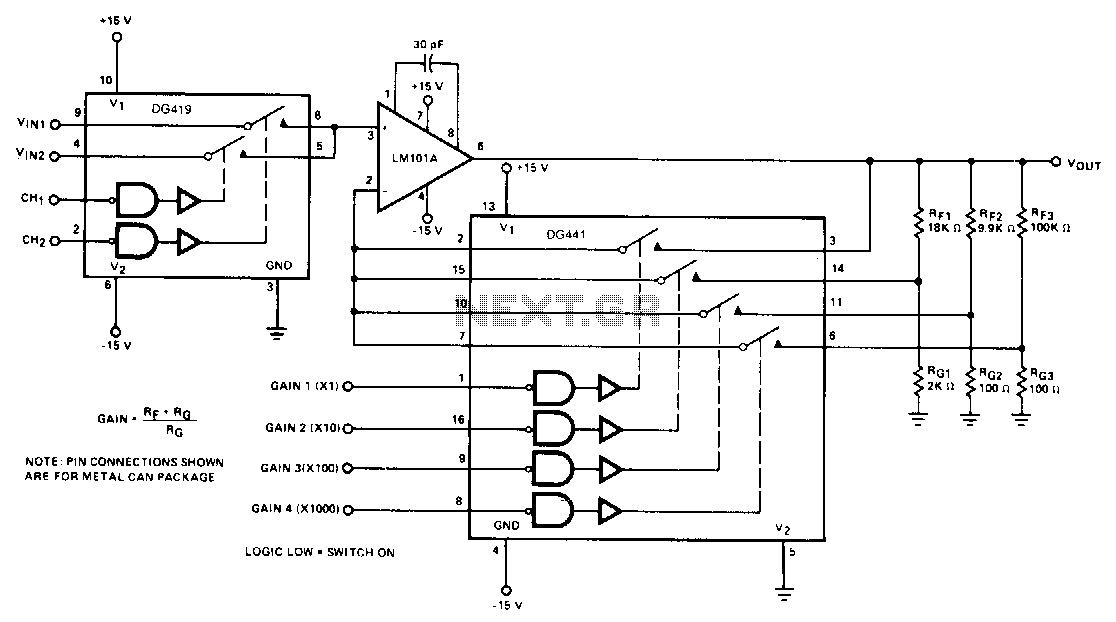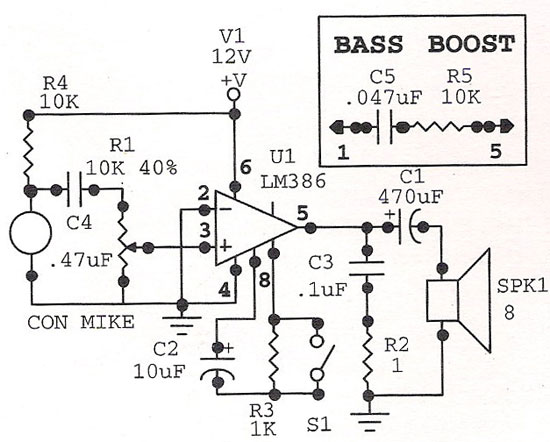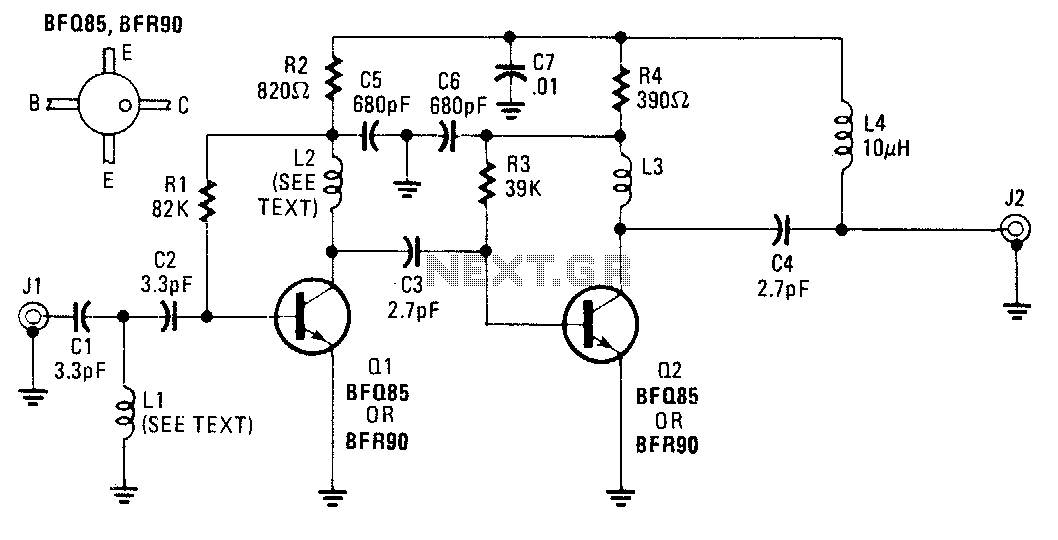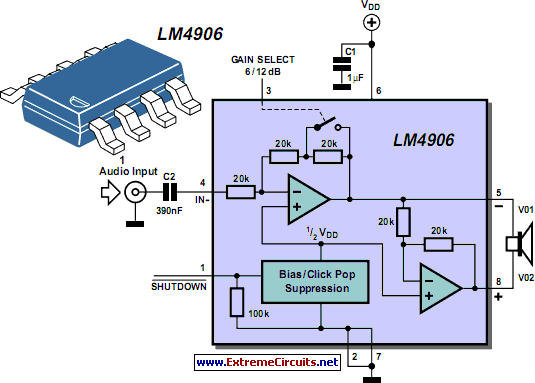
15 Watt Amplifier
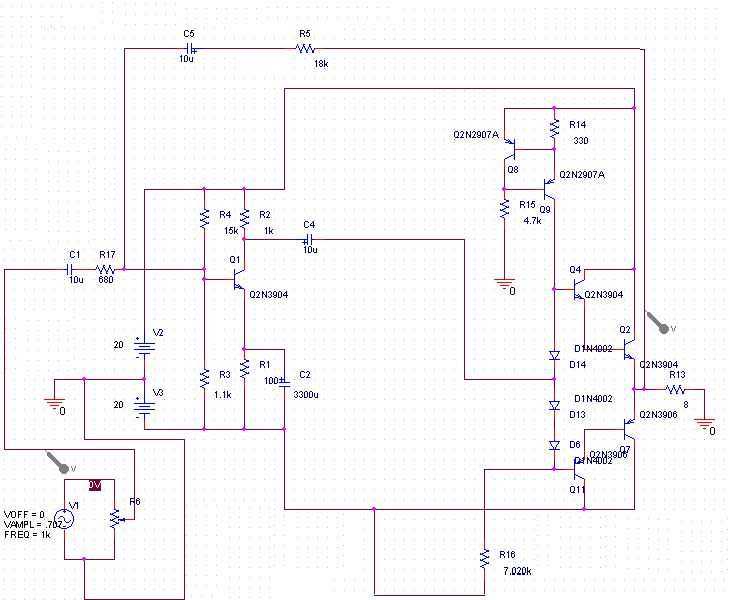
You can use this circuit with any walkman or CD player since it is designed to take a standard 500mv RMS signal. A 15 watt amplifier made using discrete components. Sergio designed this circuit for his Electronics Level II course. This amplifier uses a dual 20 Volt power supply and delivers 15 watts RMS into an 8 ohm load. More: Q1 operates in common emitter, the input signal being passed to the bias chain consisting of Q8, Q9, D6, D13 and D14. Q8 and Q9 provide a constant current through the bias chain to minimize distortion, the output stage formed by a discrete darlington pair.
The circuit described is a 15-watt audio amplifier designed to interface with standard audio sources such as walkmans or CD players, accepting a nominal input signal of 500 mV RMS. The amplifier operates from a dual 20 Volt power supply, which allows it to efficiently deliver 15 watts of power into an 8-ohm load, making it suitable for driving small speakers or headphones.
The input stage of the amplifier utilizes a common emitter configuration with transistor Q1, which amplifies the incoming audio signal. The biasing of Q1 is critical for ensuring linear operation and minimizing distortion. This biasing is achieved through a bias chain that includes transistors Q8 and Q9, along with diodes D6, D13, and D14. The role of Q8 and Q9 is to provide a constant current through the bias network, which stabilizes the operating point of Q1 and enhances the overall linearity of the amplifier.
The output stage is constructed using a discrete Darlington pair configuration, which consists of two transistors that work together to provide high current gain. This design choice allows the amplifier to drive the load effectively while maintaining good thermal stability and efficiency. The use of discrete components in this amplifier design offers advantages such as improved sound quality, customization potential, and ease of repair compared to integrated circuit solutions.
Overall, this amplifier circuit exemplifies a well-thought-out design for audio applications, balancing power output, distortion control, and component selection to achieve a robust and reliable performance.You can use this circuit with any walkman or CD player since it is designed to take a standard 500mv RMS signal. A 15 watt amplifier made using discrete components. Sergio designed this circuit for his Electronics Level II course. This amplifier uses a dual 20 Volt power supply and delivers 15 watts RMS into an 8 ohm load. Q1 operates in common emitter, the input signal being passed to the bias chain consisting of Q8, Q9, D6, D13 and D14. Q8 and Q9 provide a constant current through the bias chain to minimize distortion, the output stage formed by a discrete darlington pair
🔗 External reference
The circuit described is a 15-watt audio amplifier designed to interface with standard audio sources such as walkmans or CD players, accepting a nominal input signal of 500 mV RMS. The amplifier operates from a dual 20 Volt power supply, which allows it to efficiently deliver 15 watts of power into an 8-ohm load, making it suitable for driving small speakers or headphones.
The input stage of the amplifier utilizes a common emitter configuration with transistor Q1, which amplifies the incoming audio signal. The biasing of Q1 is critical for ensuring linear operation and minimizing distortion. This biasing is achieved through a bias chain that includes transistors Q8 and Q9, along with diodes D6, D13, and D14. The role of Q8 and Q9 is to provide a constant current through the bias network, which stabilizes the operating point of Q1 and enhances the overall linearity of the amplifier.
The output stage is constructed using a discrete Darlington pair configuration, which consists of two transistors that work together to provide high current gain. This design choice allows the amplifier to drive the load effectively while maintaining good thermal stability and efficiency. The use of discrete components in this amplifier design offers advantages such as improved sound quality, customization potential, and ease of repair compared to integrated circuit solutions.
Overall, this amplifier circuit exemplifies a well-thought-out design for audio applications, balancing power output, distortion control, and component selection to achieve a robust and reliable performance.You can use this circuit with any walkman or CD player since it is designed to take a standard 500mv RMS signal. A 15 watt amplifier made using discrete components. Sergio designed this circuit for his Electronics Level II course. This amplifier uses a dual 20 Volt power supply and delivers 15 watts RMS into an 8 ohm load. Q1 operates in common emitter, the input signal being passed to the bias chain consisting of Q8, Q9, D6, D13 and D14. Q8 and Q9 provide a constant current through the bias chain to minimize distortion, the output stage formed by a discrete darlington pair
🔗 External reference
